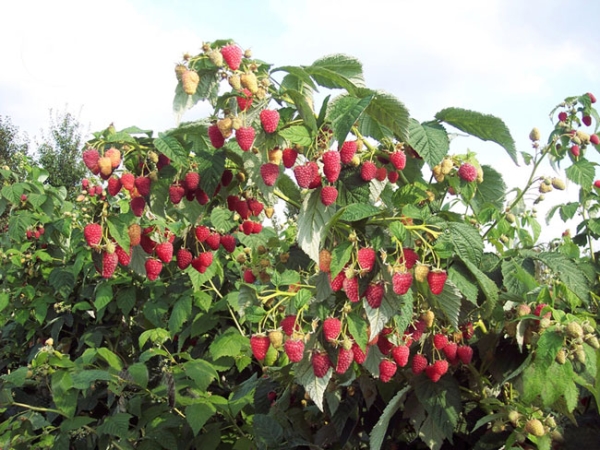Surely everyone heard the phrase raspberry tree. The first grade of this tree was raspberry tarusa.
This is a sort of summer raspberry, which acquired as a result of crossing a thick trunk that resembles a tree.
Table of contents
Description of the standard variety Tarusa
Raspberry tarusu created in 1987: scientists led by the popular breeder V.V. Kichin crossed two types of raspberries - "Stolichnaya" and the donor "Stambovy-1".In 1993, this variety entered the market.
Tarusa shoots resemble wood. They are dense, differ in thickness, elasticity and straightness. They are also devoid of thorns.
Maturation occurs in the second half of July. Favorable conditions for growing Tarusa - regions with a predominantly dry climate. Numerous sediments can kill the crop.
Young shoots are painted in a light green shade and covered with a light wax coating. The leaves are voluminous, heart-shaped with veins, which are brightly drawn.
Variety Tarusa characterized by stable winter hardiness. He is able to survive at temperatures up to -30 degrees. Therefore, you can grow in warm regions and where the cold winters.
Raspberry fructifies the whole summer without interruptionfrom the beginning of July until the end of August.
Features "raspberry tree" and the characteristics of berries
The peculiarity of this raspberry variety is that the branches interlock with each other, which reduces shoots during growth.
Tarusa berries of considerable size - average fruit weight is 7-10 grams. They are bright red with drupes. The berries have the shape of a blunt cone. It is not always even - there are curves with a double stalk.
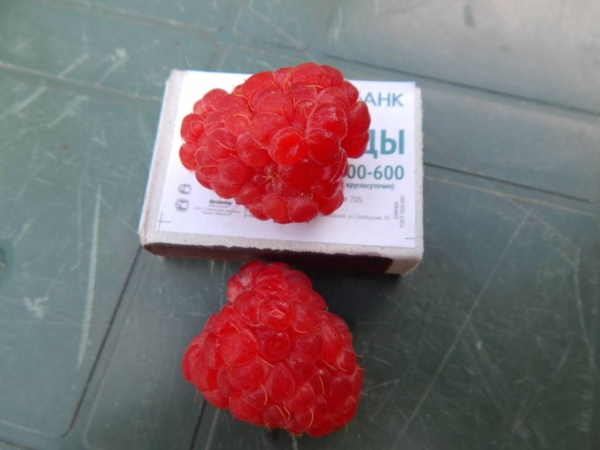
Raspberry tastes not so good, often used for culinary preparations. On the market, it is in high demand, as raspberries are easy to transport and it has an attractive shape of berries.
The shoots are strong, but because of the high yield, they lean to the ground. Because of strong winds, the crop suffers. therefore It is recommended to tie the bushes to the pegs for stability.
Advantages and disadvantages
Any variety there are drawbacksand this is no exception:
- instability to strong frosts;
- thorough care with the use of agricultural technology;
- abundant growth - in the first year of planting sprouts up to 20 shoots;
- the berries are not always large, as they are said to be - a special gene is needed for this, the absence of which leads to instability;
- not so sweet and rich taste.
You may also be interested in articles:
But in the case of raspberries benefits attract gardeners:
- large fruits;
- high yields - even in cases of the disease it does not decrease;
- easy transportation;
- lack of thorns on the trunks;
- disease resistance.
Selection of a site for cultivation and soil preparation
When choosing a site and preparing the soil remember these recommendations:
- It is worth choosing areas that receive a large amount of light, do not have the shadow of houses and other buildings.
- For raspberries, choose a separate section or plant around the perimeter, along the fences.
- Do not plant next to strawberries, tomatoes and potatoes. It can cause some diseases.
- After 8-10 years, raspberries should be transplanted to a new place. This is recommended so that the yield does not decrease, since it has already taken up trace elements from the soil at this place. At this site to plant raspberries again, you can after 5 years.
- Variety loves moisture and abundant watering. Ensure regular hydration during the first weeks after planting.
- But do not overdo it with moisture, as the shoots die.When choosing a site, remember - groundwater is located at no more than 1.5 meters.
- Soil choose loose and rich in minerals. This is loamy and sandy soil.
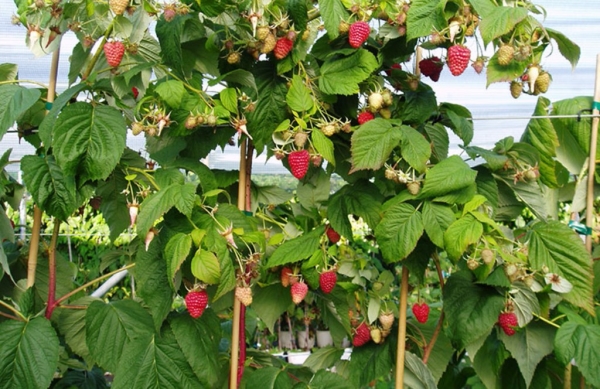
Landing time:
- You can start planting raspberries in the spring and autumn. Remember that if planting occurs in the spring months, then you need to plant as soon as possible. Seedlings planted in the spring, will yield only after the first year.
- In warm autumn, strong vegetation is possible - the growth of seedlings. Because of this, they will die in the winter. Therefore, it is worth planting raspberries in the second half of October.
- Often the time of planting depends on the region of residence. The ideal time is mid September - the end of November and the beginning of March - the end of April.
Rules for planting and caring for raspberries
Planting raspberry tarusa:
- when planting several crimson trees at once, holes are dug out at a distance of 50-60 centimeters from each other;
- put fertilizer on the bottom of each well.As it is perfect ash and bird droppings;
- place the seedling in the middle of the hole and plant it at the depth in which it grew in the nursery or the place where it was purchased - not higher and not lower than the level of the root neck. If the soil is light, then you need to plant a seedling to a depth of 6-7 centimeters;
- fill the hole with earth and tamp at the base;
- cut the shoots. Leave no more than 25-30 centimeters on the ground;
- Mulch the ground near the barrel. As a mulch, use humus;
- pour water - 5 liters per bush;
- for 2-3 days after planting, create a shade of plants, protect from direct sunlight.
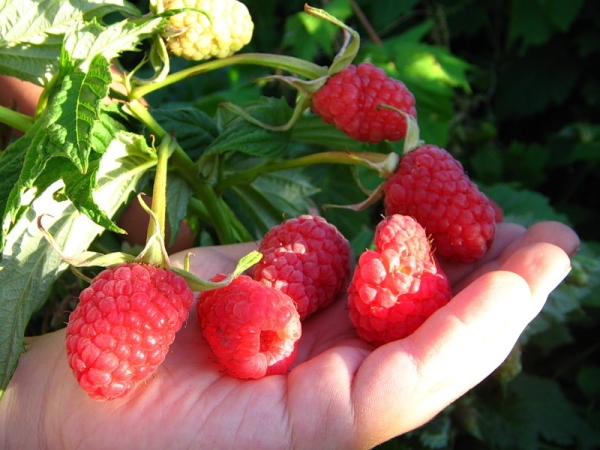
After planting a raspberry is required provide meticulous care:
- after planting it is recommended to moisten the soil. The soil should not be dry, but also very wet, so as not to destroy the root system;
- in hot summer, it is required to constantly mulch the soil. Use onion peel as a mulch;
- provide raspberry feedings. Urea or chicken droppings can be used;
- constantly rid the raspberries from weeds;
- in case of wood damage from frost, it is necessary to spray it with a special solution;
- in the second half of July, pruning shoots;
- at the end of September and beginning of October it is worth forming bushes. Trim the tip to 15-20 centimeters and remove bad shoots;
- in the first year to provide protection from frost - to warm the ground near the trunk;
- time to destroy pests.
Harvesting
After the fruit ripens, start picking the berries immediately., as they quickly crumble. It begins to ripen from mid-July.
After picking the berries are very tenderso do not immediately pour them. If you plan to transport the raspberries to another place, then it is better to collect it together with the stem. So it will not let out juice and will be stored longer.
Diseases and pests
This raspberry variety is good because it is resistant to diseases and pests. But still some of his adversaries are striking.
The most popular raspberry visitor Tarusa - aphid. If you carefully care for the bushes, then deal with it will be even in the early stages.
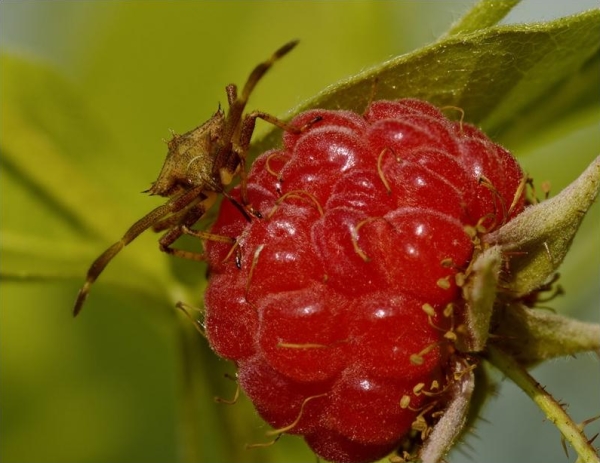
Common pests and diseases of raspberry:
- Chlorosis. The appearance of light yellow spots on the leaves, reduced yields, developmental delay. This is due to the fact that the soil suffers from a lack of moisture.
- Raspberry beetle. The plant has eaten leaves and flowers. As a result, yield and quality are reduced. To fight it is worth loosening the soil at the base and spray it with a solution of potassium permanganate.
- Raspberry moth. In early spring, gnawing buds. Because of this, the plant develops very slowly. To fight should cut all the shoots to the ground. When the buds swell the bushes are sprayed with a solution of anabizin sulfate, lime and water.
- Raspberry-strawberry weevil. It multiplies in buds and bites off the stem. Because of this, the branches of plants die and fall away. To combat using the drug Iskra-M.
- Aphid. She settles at the ends of young leaves, because of what they turn yellow and curl. If the plant is strongly affected by aphids, then it dies. To fight you need to remove all dead leaves and burn. In the case of aphids, it is assembled by hand. Before the raspberry begins to bloom and when it has already finished flowering, it is necessary to spray the seedlings with a solution of bitoxibacillin.
Much depends not on the grade, but on the right care. Proper care is an important part. for high yield. Combined with the desire to grow good fruit, you get an excellent result.
